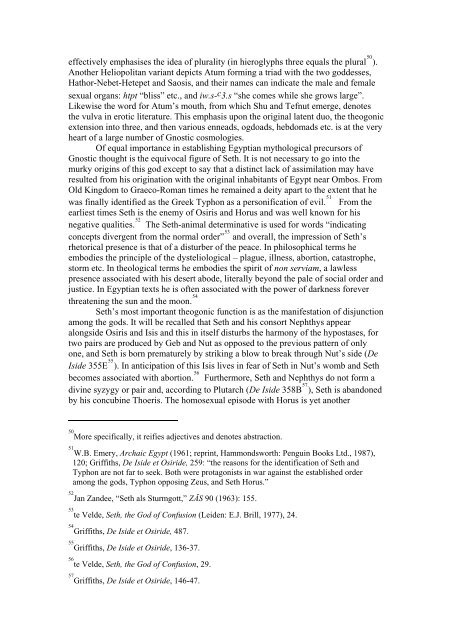THE EGYPTIAN FOUNDATIONS OF GNOSTIC THOUGHT
THE EGYPTIAN FOUNDATIONS OF GNOSTIC THOUGHT
THE EGYPTIAN FOUNDATIONS OF GNOSTIC THOUGHT
Create successful ePaper yourself
Turn your PDF publications into a flip-book with our unique Google optimized e-Paper software.
effectively emphasises the idea of plurality (in hieroglyphs three equals the plural 50<br />
).<br />
Another Heliopolitan variant depicts Atum forming a triad with the two goddesses,<br />
Hathor-Nebet-Hetepet and Saosis, and their names can indicate the male and female<br />
sexual organs: htpt “bliss” etc., and iw.s-c3.s “she comes while she grows large”.<br />
Likewise the word for Atum’s mouth, from which Shu and Tefnut emerge, denotes<br />
the vulva in erotic literature. This emphasis upon the original latent duo, the theogonic<br />
extension into three, and then various enneads, ogdoads, hebdomads etc. is at the very<br />
heart of a large number of Gnostic cosmologies.<br />
Of equal importance in establishing Egyptian mythological precursors of<br />
Gnostic thought is the equivocal figure of Seth. It is not necessary to go into the<br />
murky origins of this god except to say that a distinct lack of assimilation may have<br />
resulted from his origination with the original inhabitants of Egypt near Ombos. From<br />
Old Kingdom to Graeco-Roman times he remained a deity apart to the extent that he<br />
was finally identified as the Greek Typhon as a personification of evil. 51<br />
From the<br />
earliest times Seth is the enemy of Osiris and Horus and was well known for his<br />
negative qualities. 52<br />
The Seth-animal determinative is used for words “indicating<br />
concepts divergent from the normal order” 53<br />
and overall, the impression of Seth’s<br />
rhetorical presence is that of a disturber of the peace. In philosophical terms he<br />
embodies the principle of the dysteliological – plague, illness, abortion, catastrophe,<br />
storm etc. In theological terms he embodies the spirit of non serviam, a lawless<br />
presence associated with his desert abode, literally beyond the pale of social order and<br />
justice. In Egyptian texts he is often associated with the power of darkness forever<br />
threatening the sun and the moon. 54<br />
Seth’s most important theogonic function is as the manifestation of disjunction<br />
among the gods. It will be recalled that Seth and his consort Nephthys appear<br />
alongside Osiris and Isis and this in itself disturbs the harmony of the hypostases, for<br />
two pairs are produced by Geb and Nut as opposed to the previous pattern of only<br />
one, and Seth is born prematurely by striking a blow to break through Nut’s side (De<br />
Iside 355E 55<br />
). In anticipation of this Isis lives in fear of Seth in Nut’s womb and Seth<br />
becomes associated with abortion. 56<br />
Furthermore, Seth and Nephthys do not form a<br />
divine syzygy or pair and, according to Plutarch (De Iside 358B 57<br />
), Seth is abandoned<br />
by his concubine Thoeris. The homosexual episode with Horus is yet another<br />
50<br />
More specifically, it reifies adjectives and denotes abstraction.<br />
51<br />
W.B. Emery, Archaic Egypt (1961; reprint, Hammondsworth: Penguin Books Ltd., 1987),<br />
120; Griffiths, De Iside et Osiride, 259: “the reasons for the identification of Seth and<br />
Typhon are not far to seek. Both were protagonists in war against the established order<br />
among the gods, Typhon opposing Zeus, and Seth Horus.”<br />
52<br />
Jan Zandee, “Seth als Sturmgott,” ZÄS 90 (1963): 155.<br />
53<br />
te Velde, Seth, the God of Confusion (Leiden: E.J. Brill, 1977), 24.<br />
54<br />
Griffiths, De Iside et Osiride, 487.<br />
55<br />
Griffiths, De Iside et Osiride, 136-37.<br />
56<br />
te Velde, Seth, the God of Confusion, 29.<br />
57<br />
Griffiths, De Iside et Osiride, 146-47.










